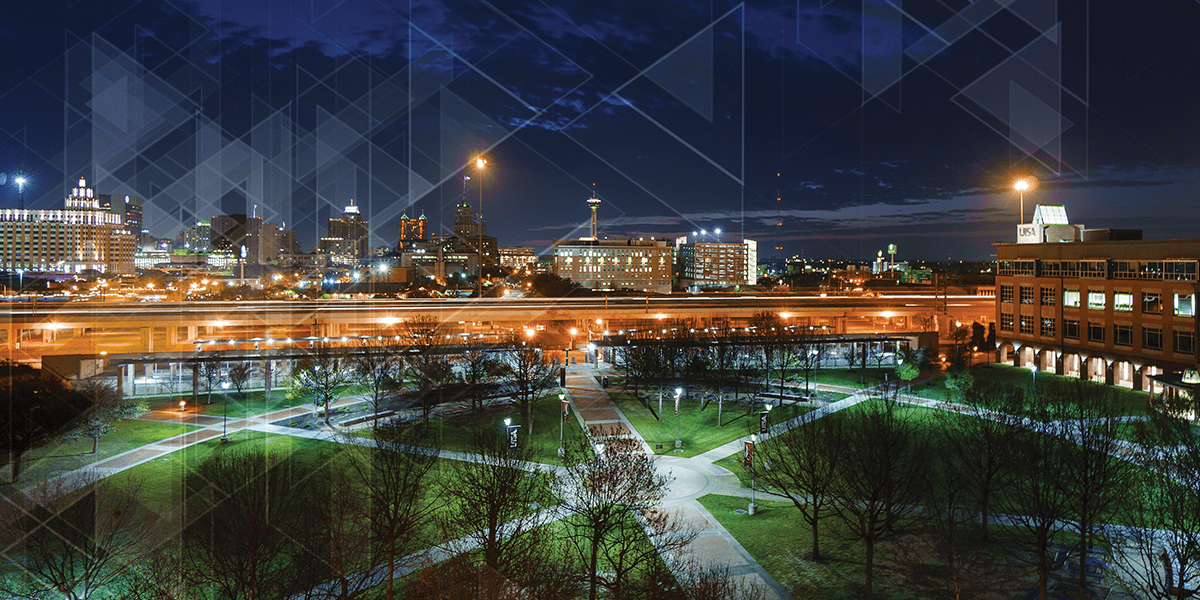
Since 2019

Since 2019
Originally Posted 1/14/2019 |
FROM THE WINTER/SPRING 2019 ISSUE
When the U.S. Army Research Laboratory, the largest source of integrated research and analysis in the Army, wanted to establish a program for cyber research, representatives visited about 30 universities nationwide. They knew after coming to UTSA they found the right fit. “UTSA is the best location for the cyber program because of the university’s incredible breadth and depth for cybersecurity research,” says Raymond Bateman, the Army’s on-site lead. “The proximity to the National Security Agency in Texas, the U.S. Secret Service, the Federal Bureau of Investigation, the 24th and 25th Air Force—all contribute to the partnership of the nationally critical cyber mission.”
In January 2017 ARL leaders told UTSA they would like to move on to campus and 60 days later an in-house facilities team had renovated and repurposed a suite of offices in the North Paseo Building. That kind of detail might seem trivial, but in what’s often viewed as a slow-moving government and academia atmosphere it exemplifies a get-it-done attitude that has helped UTSA push boundaries and establish partnerships, such as the university’s new National Security Collaboration Center.
“We are on a trajectory to become more research intensive.”
Born from working with the ARL and other federal partners, the NSCC is bringing together academia, government, and industry in a way unlike any other in the country. “When it comes to cyber,” Bateman says, “it’s not just an Army issue or a Department of Defense issue. It has become a global issue. We have to collaborate to speed up research and development of effective cyber tools, and this center is going to bring to the table the best that government, academia, and industry have to offer, making the NSCC vitally relevant at a critical time in our history.”
The creation of the NSCC is just one example of how UTSA is aggressively establishing itself as a great public research university, a model of student success, and an exemplar for strategic growth and innovation—three destinations set by President Taylor Eighmy.
In building on the past 50 years and with the goal of meeting the objectives laid out in those three areas, Eighmy has launched a flurry of presidential initiatives. As of late last year the initiatives announced include creating a campus master plan, increasing experiential learning for students, focusing on strategic enrollment, and expanding the Downtown Campus, where the College of Business and College of Education and Human Development [see related article “Big Data Gets Schooled”] will eventually move. Additional residence halls, a public-private tech venture called Tricentennial Innovation Park, and a Roadrunner Athletics Center of Excellence [see related article “Game Changer”] are planned for Main Campus.
The university is not moving forward in a bubble, though, with input sought from business and community leaders, local and state politicians, and other stakeholders. The excitement built by these partnerships could be felt this past September, when the university announced its downtown expansion plans, which included a promise of $70 million from the UT System, a pledge of $15 million from Graham Weston to help build a new School of Data Science [see related article “Expanding Together”], and land agreements with both the City of San Antonio and Bexar County.
“We want to attract the best and brightest faculty, but everyone else wants to attract them too,” says Bernard Arulanandam, UTSA’s interim vice president for research, economic development, and knowledge enterprise and the Jane and Roland Blumberg Professor in Bioscience, who is leading the university’s newly launched Presidential Initiative on Research Excellence. “You have to give them a value proposition of why they should come to UTSA. Well, come to UTSA because we are on a trajectory to become more research intensive and we have these tremendous facilities and resources to make you successful in whatever discipline you are in. And that translates to the signature experience that we want to give both our undergraduate and graduate students.”
Growing Strategically
Max Kilger, associate professor in practice, is no stranger to starting new programs. Just a few years ago he helped create a new master’s degree in data analytics. Now, with a $2 million boost from a Defense Intelligence Agency grant, plus the benefit of the NSCC effort, the master’s program will expand even further. It will include a track in analytics cyber intelligence, launch an intelligence certificate program, award scholarships and stipends, and collaborate with academic and industry partners on cyber analytics training and research as well as work with the intelligence community to promote internship and job opportunities. “This program produces sort of a 360-degree picture of the threat environment,” Kilger says. “It’s using traditional data analytics, applying the special cyber domain of knowledge to analytics, and applying what we know about the human element—all in the threat environment.”
Learning to understand the relationship between people and technology creates a powerful, multidimensional program that will help graduates land jobs, Kilger says, and the program needs bright, sharp students with strong analytical skills and curiosity. “It’s a challenging and rigorous program. It’s a tough program,” he says. “But in the end graduates will be incredibly well-prepared to begin a career in this area.”
Paul Rad, an associate professor in the information systems and cybersecurity department, is co–principal investigator on the grant, which designates the program and the university as an Intelligence Community Center of Academic Excellence.
The program will eventually be housed within the new School of Data Science. Site planning and design for the new school and the NSCC have already begun, with construction expected to start in the fall. Construction of the new College of Business should begin in 2020. The three downtown projects total $229 million in value, once all funding and property transfers are completed.
With the downtown initiatives under way UTSA will have more room on Main Campus to expand other academic and research programs, including brain health, infectious disease, regenerative medicine and medicinal chemistry, engineering, and liberal and fine arts. And the new $95 million Science and Engineering Building, currently under construction, is slated to open in 2020. The 153,000-square-foot facility will house the recently added chemical engineering program plus classrooms, laboratories, and collaboration space. This spring semester also marks the opening of UTSA’s Large-Scale Structural Testing Facility, which will be used by civil engineering faculty and students for simulating structural challenges in bridges and buildings.
Expanding facilities in a strategic way and building on faculty cluster hires [see “Cluster Analysis” in Sombrilla Magazine, Fall/Winter 2018] will grow UTSA’s knowledge enterprise, which Arulanandam says comprises three elements: “It’s the talent of people we have at UTSA—the faculty, staff, and students; second, it’s the ability to harness their creativity or their ingenuity; and the third ingredient is how do we then create an environment where you take the talented people with the great ideas and create those miracle outcomes.”
Research expenditures already are increasing, so adding to the knowledge enterprise will further enable UTSA to meet Eighmy’s goal of qualifying for the state National Research University Fund by 2020 and achieving Carnegie Classification R1, a university with “highest research activity.” Arulanandam stresses that UTSA’s focus is not just on STEM fields, studies related to science, technology, engineering, and mathematics. “No comprehensive research university can flourish without the fine arts or humanities,” he explains. “Transdisciplinary research actually is going to engage the fine arts and the humanities and STEM fields together in the future.”
Student Success
UTSA computer science professor Shouhuai Xu has made it his life’s work to research ways to make the internet safer and pass on that knowledge to his students. “We don’t have enough research,” he says, “but we’re getting there. It means a lot of effort. I’m very optimistic. Think about medical science; it’s been around thousands of years if you think about from the time of elementary medical science. We’ve invested tons of money, and there are still diseases we can’t cure. Cybersecurity is just decades old. This is just the beginning, and we have a long way to go. This is why I teach.”
“We have these tremendous facilities and resources to make [students] successful in whatever discipline.”
Graduate students are working on two of Xu’s high-profile research projects that aim to help defend against cyberattacks. One project, funded by a $1.6 million grant from the ARL, looks at whether cyberattacks can be forecast, much like the weather. The other, funded with a $500,000 National Science Foundation grant, is working to develop a malware recognition algorithm that will unmask malicious software.
Cutting-edge research like the projects in Xu’s Laboratory for Cybersecurity Dynamics helps attract students to UTSA and make them successful in the workforce, says Arulanandam. “We have to consider, Why do students need to come to UTSA? I would put the value proposition on the research, faculty, and infrastructure. Because students say they want to come here to work with Professor X, Y, or Z because he or she is working on something really cool.”
Another part of student success is increasing their quality of life. First-generation students now have a dedicated wing in Alvarez Hall. Campus expansion plans also call for an Honors College residence hall and mixed-use developments on both campuses. “The new honors residential hall is a defining moment in the history of the college,” Dean Sean Kelly says. “This space will house a transformative live-learn community, allowing students to have the small liberal arts college experience here at UTSA, while enjoying all the benefits of a comprehensive state university. We will use this opportunity to put the college in the national honors spotlight and anticipate significant increases in enrollment as its completion nears.”
The new residence and commercial development, dubbed Roadrunner Village, will bring a much-needed sense of urban walkability, while providing affordable housing for students as well as amenities to serve students living in off-campus complexes along UTSA Boulevard.
Downtown, a Cattleman Square residential tower will expand the campus’s current footprint. Planned to be developed as a public-private partnership, it will feature street-level retail, restaurants and services, underground parking, student housing, and academic spaces.
By building the knowledge enterprise, attracting first-rate faculty, and retaining the best and brightest students, UTSA’s momentum continues to grow. “If you look ahead 10 years, UTSA’s impact will be even deeper than it is today,” President Eighmy says, “with multiple campuses, more faculty, a larger graduate student population, and a research enterprise among the best in Texas.”

